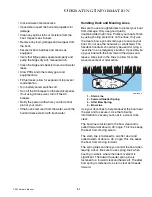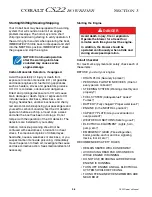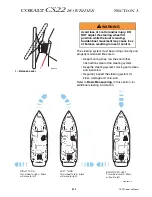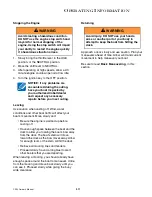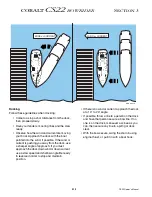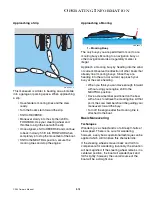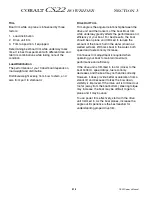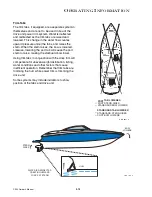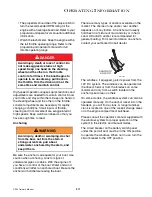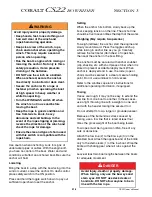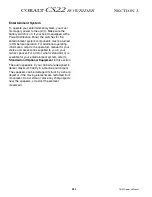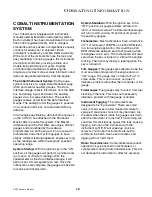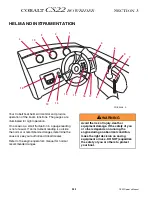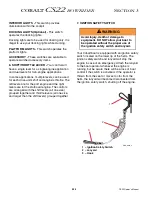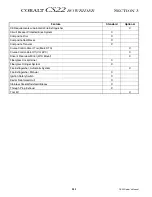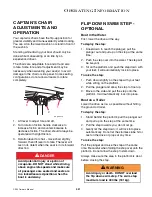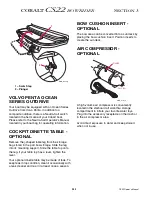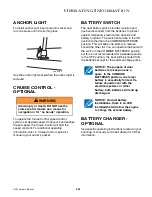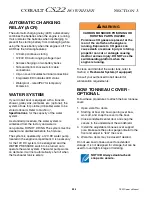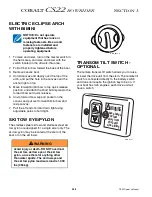
CS22 Owner’s Manual
3
-
21
O
PERATING
I
NFORMATION
COBALT INSTRUMENTATION
SYSTEM
Your Cobalt boat is equipped with instruments
manufactured by Medallion Instrument Systems.
Each instrument has been manufactured in an ISO
9001-2000 registered facility, built to stringent
standards and has passed a comprehensive quality
control procedure prior to shipment. Each
instrument is backed by a limited lifetime warranty.
While most of the instruments have the look and
easy readability of analog gauges, the instruments
are digitally controlled, providing reliable and
trouble-free performance for years. Digitally
controlled instrumentation simplifies engine
diagnosis, provides more accurate information and
data can be generated directly from the engine.
The Cobalt Instrument System:
Each gauge
system consists of a single Data Interface Gauge
(DIG) and several auxiliary gauges. The Data
Interface Gauge collects information from the CAN
bus and analog inputs and drives the auxiliary
gauges via a low-speed data bus. The auxiliary
gauges receive power from the Data Interface
Gauge. The backlight of all the gauges is powered
on a connector terminal, not associated with any
data bus.
In twin-engine applications, data for both engines is
on the CAN (P) bus attached to the Starboard
Master DIG to enable this system. The Master
(Starboard) and the Port DIGs are unique, distinct
gauges and are defined by the software
programmed into each gauge. It is not unusual for
tachometers and other system gauges to have
slightly different readings between engines as long
as the readings are within the engines’ specified
operating range.
System Startup:
With the ignition key in the “ON”
position, all the gauges will perform a pointer reset
(go to zero, or minimum reading). With the
speedometer as the Data Interface Gauge, it will
perform an LCD all-segments-on test. Once the
initializations are complete, the gauges will be able
to receive and display data.
System Shutdown:
With the ignition key in the
“OFF” position, all gauge pointers will return to
“zero” or minimum value. The Data Interface Gauge
will turn its LCD window off and shut off power to
the auxiliary gauges.
Tachometers:
Most tachometers have a tolerance
of 2% of full scale (120 RPM on a 6000 RPM tach).
In a twin-engine application, this could be a 240
RPM difference between each tach reading when
the engines are in sync. The tachometers will read
zero when the key is turned on, without the engine
running. The tach may display a reading when the
key is turned off.
Trim Gauges:
Trim gauges are calibrated to be the
most accurate and useful in the engine down or
“trim” range. The gauge may not read full “up” in
some cases. This is not unusual, nor does it
indicate a problem with either the trim sender or the
gauge.
Fuel Gauges:
Fuel gauges may “bounce” from fuel
sloshing in the tank. This does not necessarily
indicate a problem with the gauge or sender.
Instrument Fogging:
The instruments are
designed to be “fog resistant.” There are small
vents in their cases to allow trapped moisture to
escape. Occasionally moist air may be drawn into
the vents when the air inside the gauge cools down,
after the instrument is turned off. The morning sun
can draw this moisture up against the lens, causing
fogging. Turning on the instrument with the
instrument light “ON” will speed up moisture
removal. Your Cobalt instruments are built to
withstand the harsh marine environment, and
fogging will not harm them.
Radio Transmissions:
Some interference (erratic
operation) may be noticed on tachometers or
synchronizers during radio transmissions. This will
not damage the instrument or affect its accuracy.
Summary of Contents for CS22
Page 2: ...ii CS22 Owner s Manual COBAL T CS22 BOWRIDER ...
Page 8: ...viii CS22 Owner s Manual COBAL T CS22 BOWRIDER NOTES ...
Page 60: ...2 30 CS22 Owner s Manual COBAL T CS22 BOWRIDER SECTION 2 NOTES ...
Page 102: ...4 4 CS22 Owner s Manual COBAL T CS22 BOWRIDER SECTION 4 ...
Page 124: ...6 10 CS22 Owner s Manual COBAL T CS22 BOWRIDER SECTION 6 NOTES ...
Page 132: ...7 8 CS22 Owner s Manual COBAL T CS22 BOWRIDER SECTION 7 NOTES ...

